Modern CPU’s computing power has skyrocketed over time, but some power-hungry users always remain who need insane computing power more than regular desktop processors. These users are mainly 3D artists, game designers, VFX animators, video editors, and data scientists.
Intel and AMD both have specially designed CPUs to address these users. While AMD’s Threadripper is a dedicated workstation chip, Intel uses the Xeon branding for both servers and workstations.
Contents
Threadripper VS Xeon W: Introduction
The First Xeon processor was introduced in 1998 for server platforms. However, Intel’s server Xeons now branded as Xeon Gold, Platinum, Silver, and Bronze against AMD’s EPYC lineup.
The Xeon we are talking about is the Xeon workstation part known as Xeon W, which was launched in 2017 to tackle AMD’s aggressive core war. However, the Xeon workstation/HDET processors existed before the Xeon-W branding, though they were expensive as there was no competition from AMD.
The scenario changed after AMD released ZEN architecture. Remembering the first Ryzen launch moment, AMD demonstrated their mainstream desktop Ryzen 7 against Intel 6900K- an 8-core HDET processor priced at 1K. Later, Threadrippers launched with a much higher core count, wide PCIE lane, and large cache memory.
While Intel was busy with their laptop and desktop parts, AMD targeted this market gap wisely and took market shares from them. Threadripper outperformed Xeon W heavily in synthetic and application benchmarks as they have core count with a superior fabrication process.

Intel’s silence left AMD to dominate the high-end workstation market, and AMD went crazy with Threadripper pricing as there was no competition. Even AMD didn’t release the mainstream unlocked Zen 3 / Zen 3 + Threadripper CPU for their existing sTRX4 platform. Instead, Zen 3 Threadripper PRO CPUs need an expensive sWRX8 platform.
The giant chipmaker Intel was struggling with its fabrication process. After countless delays, Intel finally got their matured 10 nm fabrication process. Not only the fabrication process, but they also stuck with old Skylake architecture for many years, and AMD took full advantage of that.
Intel’s top workstation processor was the Xeon W-3495X- a 56-core processor but nowhere close to AMD’s 64-core Threadripper processor in terms of performance. However, you could barely find these Xeon W in retail stores. Most of these parts go to system builders as they get special discounts from Intel.
All ZEN 3 Threadrippers are workstation CPUs and support 8-channel memory. ZEN 2 Thredrippers are the only option for HDET users since AMD didn’t release ZEN 3 in HDET flavors. The regular ZEN 2 supports overclocking for memory and CPU but is limited to quad memory channels instead of the 8-channel memory on the workstation parts. However, the upgrade path for both sWRX8 and sTRX4 motherboards forfeits as AMD’s ZEN 4 Threadripper has a different socket and chipset.
Threadripper VS Xeon W: Current Lineup
Intel extends its Xeon W lineup in the 3400 and 2400 series. There are several SKUs available in both series. We’ve picked the flagship Xeon W models to compare with Threadripper.
CPU | Core/Thread | Frequency | Price |
Xeon W9 3495X | 56 / 112 | 1.9GHz / 4.8GHz | |
Xeon W9 3475X | 36 / 72 | 2.2GHz / 4.8GHz | |
Xeon W7 3465X | 28/56 | 4.2GHz / 2.5GHz |
However, the 2400 series processors are limited to quad-channel memory with fewer core counts. Of course, they are cheaper compared to the flagship models. The cheapest Xeon W is the w3-2425, which is a 6-core processor and costs only $529. You can check the full Xeon W lineup here.
AMD also split Threadrippers into the PRO and X models as the previous generation. The flagship Threadripper PRO is a 96-core CPU and supports 8-channel memory. But, We’ve picked the regular 7980X/64C, 7970X/32C and 7960X/C to compare with Xeon’s top W9-3495X/56C, W9-3475X/36C, and W7-3465X/28C.
CPU | Core/Thread | Frequency | Price |
Threadripper 7980X | 64 / 128 | 3.2GHz / 5.1GHz | |
Threadripper 7970X | 32 / 64 | 4.0GHz / 5.3GHz | |
Threadripper 7960X | 24/48 | 4.2GHz / 5.3GHz |
Threadripper VS Xeon W: Performance Analysis
As Intel’s Xeon 3500 series is yet to launch, we have the Xeon 3400 series against the Ryzen 7000 Tthreadripper series. Cinebench 2024 is great for measuring CPU performance, and here is the multicore result of these core-heavy processors. The Threadripper 7980X leads the Cinebench 2024 multicore benchmark with a rocking 5600 mark. Sadly, Intel’s flagship Xeon W9-3495X – a 56-core CPU can’t keep up with the latest AMD’s 32-core TR 7970X. The cheapest 7960X/24C wipes out the W9-3475X/36C W7-3465X/28C in healthy margin.
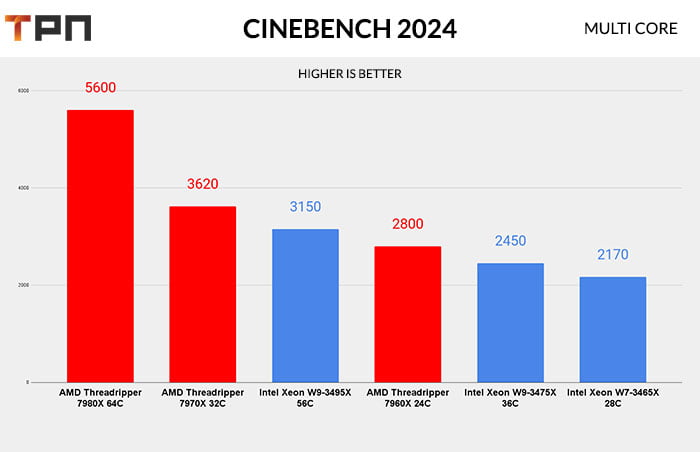
As higher-core parts have relatively lower clock speeds, we have seen TR 7970X become the top CPU in the Cinebench 2024 single-core test. This time, we have much closer results on both fronts. AMD Threadripper parts are an average of 12% faster than Xeon W in the single-core test. However, mainstream Intel 14900KS or Ryzen R9 1950X rocks the Cinebench 2024 single-core benchmark that benefits lightly threaded apps and games.
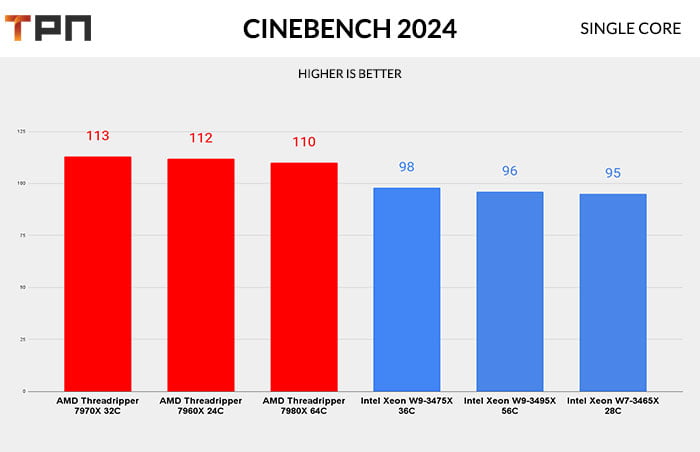
How these expensive CPUs handle real-world workloads, and Lisa Su strikes again. Threadripper smashes Xeon W in the V-Ray CPU render test. The less expensive 7970X/32C beats the $5800 Xeon W9 3495X/56C, while the flagship 7980X is miles away. At this point, we have to say that Intel needs to rethink Xeon’s multithreading implementation.
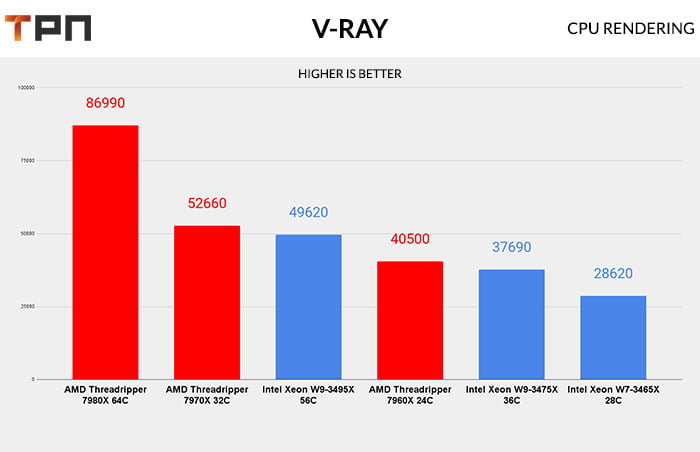
Blender’s CPU rending test repeats the same scenario. The 64-core 7980X took the performance crown as expected, but the 56-core Xeon flagship struggles to achieve the same performance level as the 7970X.
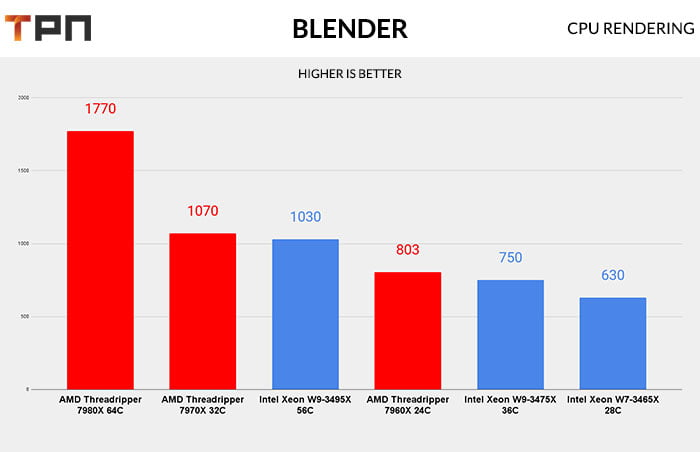
Unreal Engine shaders compilation stretches across the core very well, and this is the only benchmark where Intel Xeon W has some strength. While the 64C Threadripper 7980X secures the top place, W9-3495 beat the 32-core 7970X! However, considering the price of both CPUs, Xeon’s winning is nothing more than a joke.
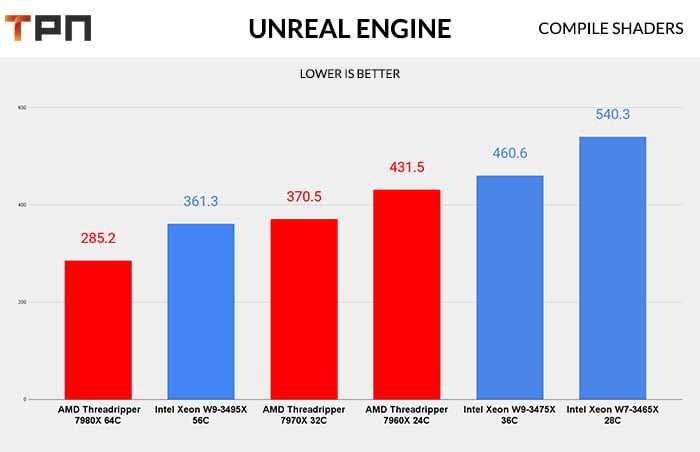
Light-threaded apps can’t take full advantage of high-core AMD or Xeon, as seen on the PugegtBench for DaVinci Resolve Studio.
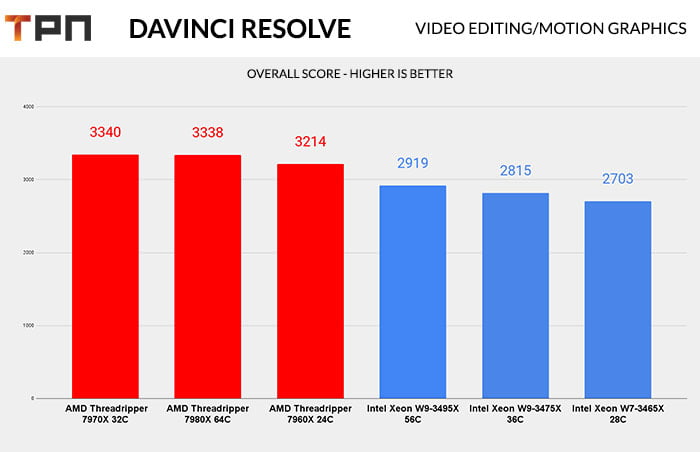
Video editing on Adobe Premiere Pro is no exception. The lowest Threadripper 7960X is enough to beat Intel’s flagship Xeon W9.
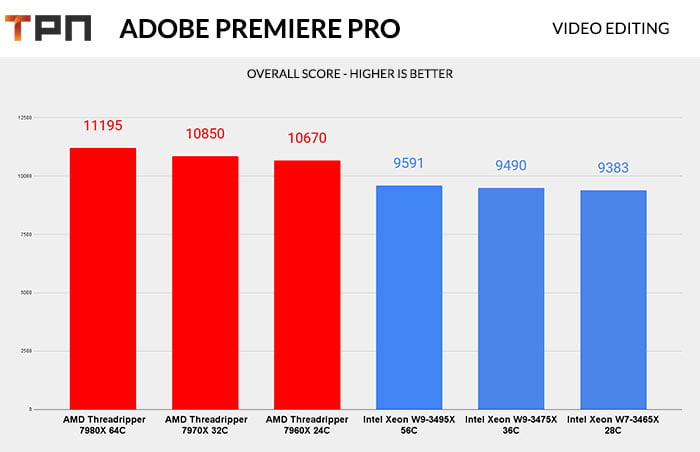
Adobe Photoshop doesn’t scale across all cores very well, and we have seen the Threadripper 7960X is leading the PugetBench for the Photosop benchmark chart. Due to lower IPC, Xeon W again fails to impress.
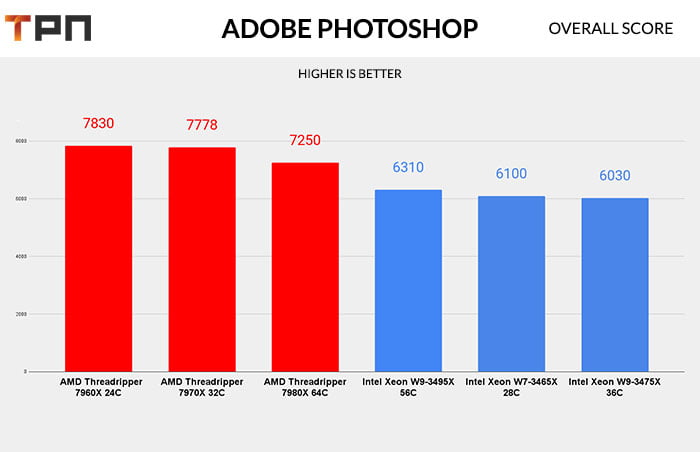
Adobe After Effects also behaves like Photoshop and has no extra benefits from these high-core count CPUs. However, AMD’s Threadrippers is the winner here, though there is no difference between 64C and 24C.
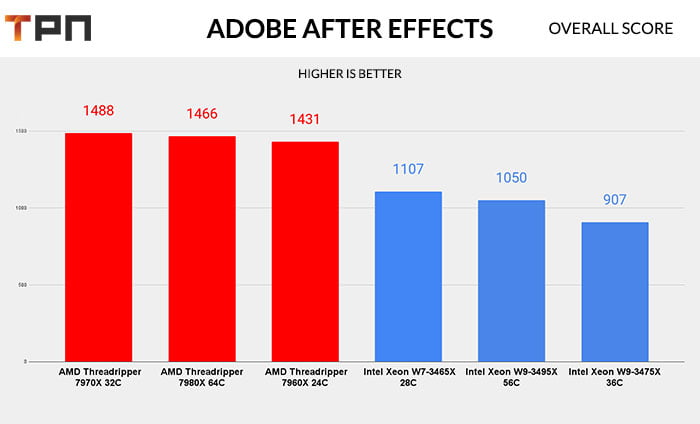
AMD’s Threadripper is undoubtedly the winner at the end of the performance summary. Now, let’s compare the motherboard available on both platforms.
Best Motherboard for Threadripper 7000
We’ve two different chipsets for AMD’s Threadripper processors – WRX90 and TRX50. The WRX90 is the most expensive platform, dedicated to PRO series processors, and has full 8-channel memory(Max 2TB) with 128 PCIe 5.0 PCI-E lanes connectivity. If you don’t mind spending $10K on the 96-core pro models, ASUS Pro WS WRX90E-SAGE SE is the best Threadripper motherboard for Threadripper Pro.
The less expensive TRX50 supports both PRO and X variants but supports only quad-channel memory(Max 1TB) and limited 48 PCIe lanes. We’ve used the GIGABYTE TRX50 AERO D in our testing, which is an excellent motherboard for the price.
ASUS, Asrock, and Supermicro also have TRX 50 motherboards, but GIGABYTE TRX50 AERO D is the cheapest TRX50 motherboard.
 |
Though, the Asus Pro WS TRX50-SAGE has a much better VRM (36 Phases) design than the GIGABYTE TRX50 AERO D(28) but costs an extra $400 premium.
Best Motherboard for Xeon W
Searching for a decent motherboard for Xeon W? We don’t have as many options as AMD’s Threadripper. Only a few motherboard makers dare to build motherboards for the LGA 4677 socket.
Here comes the ASUS Pro WS W790 SAGE SE – an expensive but capable motherboard to deliver Xeon W’s potential with full support for 8-channel memory (Max 2TB).
The ASUS Pro WS W790 SAGE SE features 7 PCIe 5.0 slots for Xeon 3400(4 for Xeon 2400), two ethernet ports, and NVME M.2 connectivity options. Asus also offers a less expensive W790 LGA 4677 motherboard, limited to quad memory channels and fewer PCIe slots, similar to ASRock W790 and Supermicro X13SRA-TF.
 |
However, you might feel ashamed when a quad-channel Threadripper surpasses the Xeon’s octa-channel memory.
Rob is a passionate tech enthusiast, reviewer, and content creator at techpowernext. With over a decade of experience in the tech industry, he dives deep into the latest gadgets, software, and innovations. His mission is to demystify complex tech concepts and empower readers to make informed decisions.

